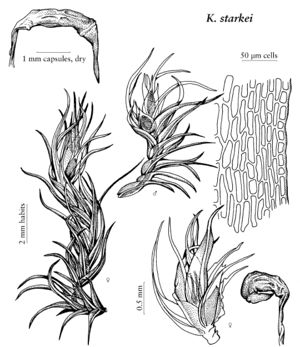Difference between revisions of "Kiaeria starkei"
Kongel. Norske Vidensk. Selsk. Skr. (Trondheim) 1914: 114. 1915,.
FNA>Volume Importer |
imported>Volume Importer |
||
| Line 56: | Line 56: | ||
|publication year= | |publication year= | ||
|special status= | |special status= | ||
| − | |source xml=https:// | + | |source xml=https://bibilujan@bitbucket.org/aafc-mbb/fna-data-curation.git/src/bb6b7e3a7de7d3b7888a1ad48c7fd8f5c722d8d6/coarse_grained_fna_xml/V27/V27_598.xml |
|genus=Kiaeria | |genus=Kiaeria | ||
|species=Kiaeria starkei | |species=Kiaeria starkei | ||
Revision as of 22:34, 27 May 2020
Plants in loose tufts, green to yellow, mostly shiny. Stems 1–2(–4) cm. Leaves mostly falcate-secund, curled at tips when dry, lanceolate, gradually subulate, 2–4.5 mm, margins distally 1-stratose; costa 50–60 µm wide at base; distal laminal cells mostly elongate (2–4:1), occasionally subquadrate, 7–9 µm wide, smooth or weakly mammillose-roughened; basal laminal cells elongate, smooth, sometimes porose, alar cells strongly inflated and differentiated from the bordering small quadrate cells. Perichaetial leaves similar to the cauline. Perigonia sessile, located just below perichaetia. Capsule distinctly ribbed when dry, urn 1.3–2 mm. Spores 13–21 µm.
Habitat: Acid rock or sandy soil in rock crevices
Elevation: subalpine to alpine elevations
Distribution
Alta., B.C., Man., Nfld. and Labr. (Nfld.), N.S., Que., Alaska, Idaho, Mont., N.H., Oreg., Wash., South America, Europe, Asia.
Discussion
Kiaeria starkei occurs frequently on vertical rock surfaces, and is distinguished by the sessile male inflorescence, which is located close to the perichaetia. It can be separated in the field from the more terrestrial K. blyttii by its shiny, falcate leaves. Subalpine forms of K. falcata are more commonly found on horizontal rock surfaces and do not have grooved sporangia.
